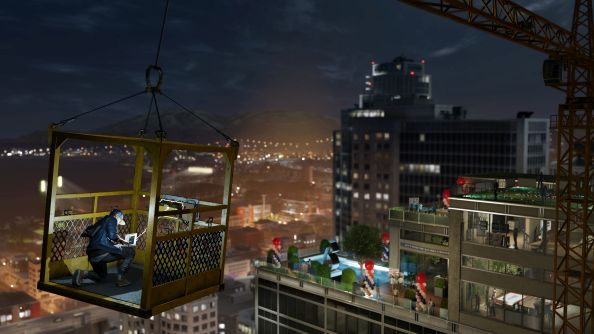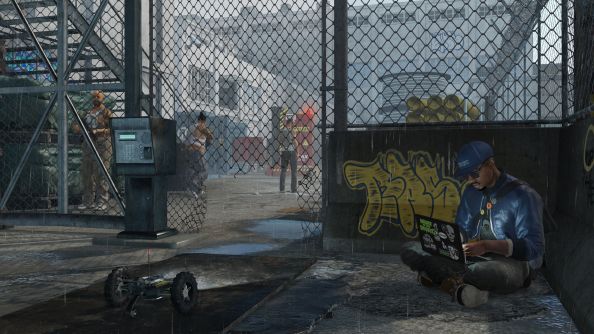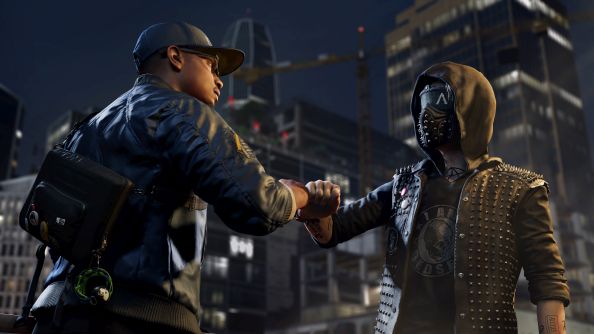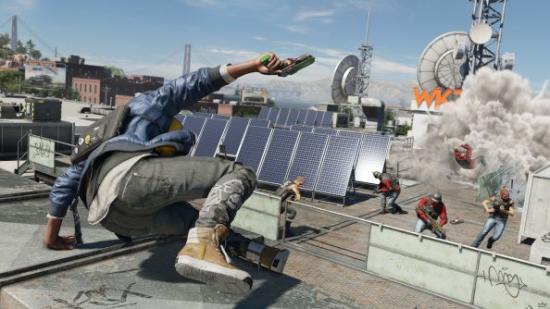Ubisoft Montreal find themselves in a spot of animus-induced deja vu with Watch Dogs 2. This is the second time they’ve had to follow an open-world game that proved a concept but didn’t fulfil its potential; a game lumbered with a po-faced plot and dullard protagonist. Do they still have it in them to pull out an Assassin’s Creed 2 to silence the haters?
For more of the happenings at E3 2016, check our homepage for the latest PC gaming news.
Having spent a little time with this new sequel, I’m convinced they’ve gone about it the right way. Watch Dogs has warmed up – leavening its tech-noir gloom with bright Silicon Valley colours, younger optimism and a player mandate to have a bit of a laugh.
Ubi have managed this by parachuting a new protagonist into the series, replacing the Uncle Batman who proved so unpopular last time around. Marcus Holloway is the Ezio to Aiden Pearce’s Altair – loud, impulsive, and frankly a lot more fun.
Crucially, he has a far healthier social life than Aiden did: Marcus runs with the hacktivist group Dedsec, who claim to defend democracy by exposing corporate interests in politics and the data control wielded by San Francisco’s social media giants.
Dedsec seem custom-designed to infuriate anybody who’s ever written a disdainful thinkpiece about ‘millennials’ – driven by self-belief and a need to conspicuously impress each other. Mission chat in Watch Dogs now sounds like a dramatic reading of a lively WhatsApp group – a mixture of mick-taking and goofing around that makes it clear these parkour-hackers are having the time of their lives.
One particular comrade-in-code, Wrench, borders on the obnoxious – screaming “F***ING A!” in your earpiece and sporting a Deadmau5-style stud-covered mask. A mask, I’m sorry to add, that covers his eyes with digital flat screens that display @s and #s as he speaks.

If Ubi occasionally slip into down-with-the-kids absurdity, however, the gains in vitality are absolutely worth it. In one mission – to invade the penthouse office of a corrupt political campaign and capture evidence of wrongdoing – Marcus pauses on the rooftop to pop in his headphones.
“Play me something fresh,” he asks a Dedsec chum, and the rest of the infiltration plays out to saxy ‘90s-style hip hop. In our demo, the scene climaxed with the remote defenestration of an indoor show car through a plate glass window. The sense of fun is unrecognisable to anybody who regularly made miserable, guilty visits to Aiden’s sister’s house, and finally matches the gleeful fantasy of remotely manipulating the modern world.
Stealth is still reliant on cover-to-cover moves stolen from Splinter Cell, and Watch Dogs 2 has also nicked Sam Fisher’s RC quadcopter for good measure – best used for scouting and marking enemies, or hovering near the top of the Coit Tower and staring out over the beautiful bay. It remains true that Watch Dogs is best enjoyed as a patient observer, taking your time rather than indulging in instincts honed by years of GTA – although Ubi have expanded the moral viability of going all-action with non-lethal tasers and electro-bombs.

Marcus moves with more verve and intent that Aiden, though his physical skillset remains largely the same. His predecessor’s brutal baton has been replaced by something more DIY – a billiard ball tied to a cord lanyard – but that’s one change that underwhelms. Marcus swings and spins the ball around his body at such speed that you feel more like spectator than perpetrator, triggering an attack before watching the yo-yo animations unfurl at length.
Watch Dogs’ online invasions were intensely hostile occurrences, but again the sequel is a friendlier experience – throwing potential co-op partners onto your streets for you to recruit with a wave emote. Shared missions can get pretty messy while you’re still getting a grasp on abilities like deployable RCs, but the game points out exactly what your partner is hacking at any one time – which ought to allow for well-coordinated distractions if you both know what you’re doing.
Development never really stopped once work wrapped on Watch Dogs, and much of what’s been altered is informed by the complaints that came afterwards. Cars were a point of contention and they certainly feel more responsive now, Ubisoft Reflections having returned to work on the driving model (their own open-world history with San Francisco, incidentally, is acknowledged as a ‘Driver SF’ app on Marcus’ phone).

There’s also greater scope for nosing through strangers’ SMS histories – the dev team have rendered every last civvie a target for spying hacks this time around – while environmental manipulation has taken on a couple of new dimensions too. This is true in the most literal sense for vehicles; a forklift truck is no longer a static object in the world with fewer moving parts than a Barbie, but an avatar you can inhabit and steer in any direction for the duration of your hack.
I learned this first-hand after jumping from a dockside rooftop onto a boom lift, from which vantage point I could have descended gently to the ground – if I hadn’t pressed the left trigger and accidentally plunged the vehicle backwards into the bay, much to the surprise of the supervising developer.
The strongest endorsement I saw for Watch Dogs 2’s emergent potential were the Ubi Montreal developers sharing stories of demos gone hilariously off-course, culminating in police chases rather than well-planned co-op sessions. It’s that potential – the way the game ripples after players hit the water of San Francisco Bay – that will determine Watch Dogs’ long-term pulling power beyond the undeniable warmth and energy it’s gained.
